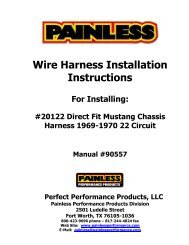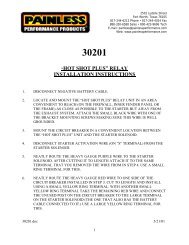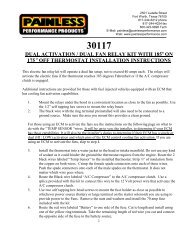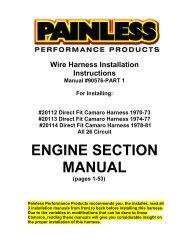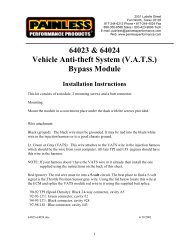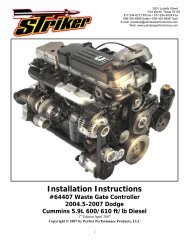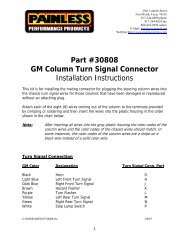Wire Harness Installation Instructions For Installing - Painless Wiring
Wire Harness Installation Instructions For Installing - Painless Wiring
Wire Harness Installation Instructions For Installing - Painless Wiring
You also want an ePaper? Increase the reach of your titles
YUMPU automatically turns print PDFs into web optimized ePapers that Google loves.
6.4 Terminal <strong>Installation</strong> and Making Connections<br />
Note: In the following steps you will be making the circuit connections. Before you start, you should<br />
carefully read Sections 7.0 through 10.0, as appropriate, and continually refer to Section 11.0, DOUBLE-<br />
CHECKING your routing and length calculations before cutting any wires and making connections. Give<br />
special attention to Turn Signal and Ignition Switch connections. These can be somewhat confusing.<br />
6.4.1 Have all needed tools and connectors handy.<br />
6.4.2 Select the correct size terminal for the wire and stud application.<br />
6.4.3 Determine the correct wire length and cut the wire. Remember to allow enough slack in the<br />
harness and wires at places where movement could possibly occur, such as automobile body to<br />
frame, frame to engine, etc. Double-check your calculations.<br />
6.4.4 Strip insulation away from wire. Strip only enough necessary for the type of terminal lug you are<br />
using.<br />
Note: In the following step, make sure that the terminal is crimped with the proper die in the crimping<br />
tool. An improper crimp will NOT make a good connection.<br />
6.4.5 Crimp the terminal onto the wire.<br />
CAUTION:<br />
DO NOT OVER-CRIMP!<br />
6.4.6 Connecting the harness throughout the groups is a redundant process. Make sure that each wire is<br />
FIRST properly routed and THEN attach. DO NOT ATTACH FIRST THEN ROUTE AFTERWARD.<br />
6.4.7 When all wires are attached, tighten the mounts and ties to secure harness permanently.<br />
6.5 Testing The System<br />
6.5.1 Use a small (10 amp or less) battery charger to power up the vehicle for circuit testing. If there is a<br />
problem anywhere, the battery charger's low amperage and internal circuit breaker will provide<br />
circuit protection.<br />
CAUTION: IF YOU HAVE NOT YET DISCONNECTED THE BATTERY FROM THE AUTOMOBILE,<br />
DO SO NOW! DO NOT CONNECT THE BATTERY CHARGER WITH THE BATTERY CONNECTED.<br />
Connect the battery charger's NEGATIVE output to the automobile chassis or engine block and its<br />
POSITIVE output to the automobile's positive battery terminal.<br />
6.5.2 INDIVIDUALLY turn on each light, ignition, wiper circuit, etc. and check for proper operation.<br />
Note: The turn signals will not flash properly if you do not have both the front and rear bulbs installed<br />
and connected.<br />
6.5.3 When all circuits check out THEN attach the battery cable to the battery for vehicle operation.<br />
8



